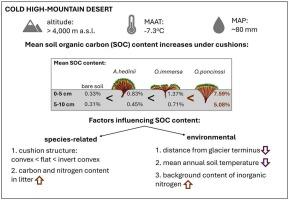Impact of differentially structured cushion plants on soil organic carbon content under dry high-mountain periglacial conditions
IF 6.6
1区 农林科学
Q1 SOIL SCIENCE
引用次数: 0
Abstract
Cushion plants are often viewed as ecosystem engineers, transforming soil conditions and supporting succession processes in dry and periglacial areas. However, the impact of the cushion plants on their habitat and other plant species may vary depending on how stressful the general conditions are. Therefore, to assess how cushion plants influence soil organic carbon (SOC) content under highly stressful environmental conditions, we conducted a study in a model area combining features typical for periglacial and hyperarid regions and characterised by one of the lowest documented organic carbon contents in soil. We selected three cushion plant species differing in morphological structure and place of litter accumulation and compared: (1) the organic carbon content in soils under the cushions against the background organic carbon values in soils outside cushions; (2) the organic carbon content in soils under the three selected species, looking for trends related to their structural differences; and (3) we studied changes in SOC content in the distance from the glacier terminus, along with the expected temperature and moisture gradients. Even under highly demanding environmental conditions, the organic carbon content in soils under the cushions was between 2.4 and 23.7 times higher than in the outside soils. The SOC content was influenced by the cushion structure, including place of litter storage, and environmental factors, including climatic features and soil characteristics. Among the latter, the most important factors were the effects of soil temperature and moisture interplay along the foreland and soil content of inorganic nitrogen. Further aridification projected for the studied area will influence the distribution and coverage of the cushion plants and impact environmental factors shaping organic carbon content under them. Hence, we may expect changes in the role of the cushion plants in nutrient storage in dry high-mountain periglacial areas.

高山冰缘干旱条件下不同结构垫层植物对土壤有机碳含量的影响
缓冲植物通常被视为生态系统工程师,在干旱和冰缘地区改变土壤条件并支持演替过程。然而,缓冲植物对其栖息地和其他植物物种的影响可能因一般条件的压力而异。因此,为了评估缓冲植物如何在高压力环境条件下影响土壤有机碳(SOC)含量,我们在一个模型区进行了研究,该模型区结合了冰缘和极度干旱地区的典型特征,并以土壤有机碳含量最低为特征之一。选择3种形态结构和凋落物聚集地点不同的垫层植物,比较垫层下土壤有机碳含量与垫层外土壤背景有机碳值;(2) 3种不同树种土壤有机碳含量,寻找与结构差异相关的变化趋势;(3)研究了离冰川终点距离的土壤有机碳含量随温度和湿度梯度的变化。即使在非常苛刻的环境条件下,垫层下土壤的有机碳含量也比外部土壤高2.4 ~ 23.7倍。土壤有机碳含量受垫层结构(包括凋落物储存地)和环境因子(包括气候特征和土壤特征)的影响。其中最主要的影响因子是沿前陆的土壤温湿度相互作用和土壤无机氮含量的影响。研究区进一步干旱化将影响垫层植物的分布和覆盖度,并影响影响垫层植物下有机碳含量的环境因子。因此,我们可以预期,在干旱的高山冰缘地区,缓冲植物在营养储存中的作用会发生变化。
本文章由计算机程序翻译,如有差异,请以英文原文为准。
求助全文
约1分钟内获得全文
求助全文
来源期刊

Geoderma
农林科学-土壤科学
CiteScore
11.80
自引率
6.60%
发文量
597
审稿时长
58 days
期刊介绍:
Geoderma - the global journal of soil science - welcomes authors, readers and soil research from all parts of the world, encourages worldwide soil studies, and embraces all aspects of soil science and its associated pedagogy. The journal particularly welcomes interdisciplinary work focusing on dynamic soil processes and functions across space and time.
 求助内容:
求助内容: 应助结果提醒方式:
应助结果提醒方式:


